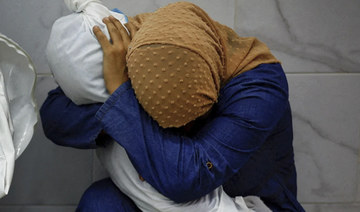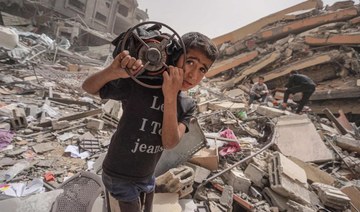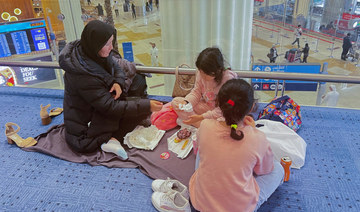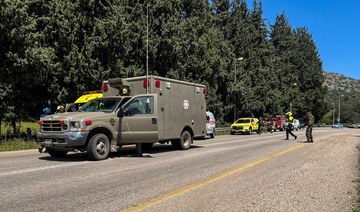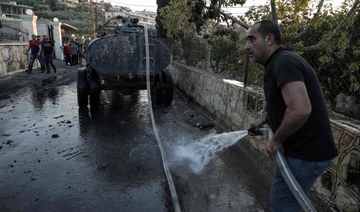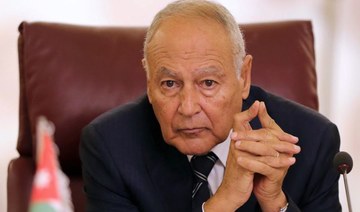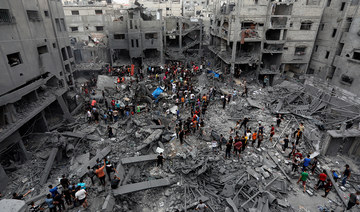BAGHDAD: On the banks of the Tigris River one recent evening, young Iraqi men and women in jeans and sneakers danced with joyous abandon to a local rap star as a vermillion sun set behind them. It’s a world away from the terror that followed the US invasion 20 years ago.
Iraq ‘s capital today is throbbing with life and a sense of renewal, its residents enjoying a rare, peaceful interlude in a painful modern history. The wooden stalls of the city’s open-air book market are piled skyward with dusty paperbacks and crammed with shoppers of all ages and incomes. In a suburb once a hotbed of Al-Qaeda, affluent young men cruise their muscle cars, while a recreational cycling club hosts weekly biking trips to former war zones. A few glitzy buildings sparkle where bombs once fell.
President George W. Bush called the US-led invasion on March 20, 2003, a mission to free the Iraqi people and root out weapons of mass destruction. Saddam Hussein’s government was toppled in 26 days. Two years later, the CIA’s chief weapons inspector reported no stockpiles of nuclear, chemical or biological weapons were ever found.
The war deposed a dictator whose imprisonment, torture and execution of dissenters kept 20 million people in fear for a quarter of a century. But it also broke what had been a unified state at the heart of the Arab world, opening a power vacuum and leaving oil-rich Iraq a wounded nation in the Middle East, ripe for a power struggle among Iran, Arab Gulf states, the United States, terrorist groups and Iraq’s own rival sects and parties.
For Iraqis, the enduring trauma of the violence that followed is undeniable — an estimated 300,000 Iraqis were killed between 2003 and 2019, according to the Watson Institute for International and Public Affairs at Brown University, as were more than 8,000 US military, contractors and civilians. The period was marred by unemployment, dislocation, sectarian violence and terrorism, and years without reliable electricity or other public services.
Today, half of Iraq’s population of 40 million isn’t old enough to remember life under Saddam or much about the US invasion. In dozens of recent interviews from Baghdad to Fallujah, young Iraqis deplored the loss of stability that followed Saddam’s downfall — but they said the war is in the past, and many were hopeful about nascent freedoms and opportunities to pursue their dreams.
In a marbled, chandeliered reception room in the palace where Saddam once lived, seated in an overstuffed damask chair and surrounded by paintings by modern Iraqi artists, President Abdul Latif Rashid, who assumed office in October, spoke glowingly of the country’s prospects. The world’s perception of Iraq as a war-torn country is frozen in time, he told The Associated Press in an interview.
Iraq is rich; peace has returned, he said, and there are opportunities ahead for young people in a country experiencing a population boom. “If they’re a little bit patient, I think life will improve drastically in Iraq.”
Most Iraqis aren’t nearly as bullish. Conversations begin with bitterness that the ouster of Saddam left the country broken and ripe for violence and exploitation by sectarian militias, politicians and criminals bent on self-enrichment or beholden to other nations. Yet, speaking to younger Iraqis, one senses a generation ready to turn a page.
Safaa Rashid, 26, is a ponytailed writer who talks politics with friends at a cozy coffee shop in the Karada district of the capital. With a well-stocked library nook, photos of Iraqi writers and travel posters, the café and its clientele could as easily be found in Brooklyn or London.
Rashid was a child when the Americans arrived, but rues “the loss of a state, a country that had law and establishment” that followed the invasion. The Iraqi state lay broken and vulnerable to international and domestic power struggles, he said. Today is different; he and like-minded peers can sit in a coffee shop and freely talk about solutions. “I think the young people will try to fix this situation.”
Another day, a different café. Noor Alhuda Saad, 26, a Ph.D. candidate at Mustansiriya University who describes herself as a political activist, says her generation has been leading protests decrying corruption, demanding services and seeking more inclusive elections — and won’t stop till they’ve built a better Iraq.
“After 2003, the people who came to power” — old-guard Sunni and Shiite parties and their affiliated militias and gangs — “did not understand about sharing democracy,” she said, tapping her pale green fingernails on the tabletop.
“Young people like me are born into this environment and trying to change the situation,” she added, blaming the government for failing to restore public services and establish a fully democratic state in the aftermath of occupation. “The people in power do not see these as important issues for them to solve. And that is why we are active.”
Signs of the invasion and insurgency have been largely erased from Baghdad. The former Palestine Hotel, Ferdous Square, the Green Zone, the airport road pockmarked by IED and machine-gun attacks have been landscaped or covered in fresh stucco and paint.
The invasion exists only in memory: bright orange flashes and concussions of American “shock-and-awe” bombs raining down in a thunderous cacophony; tanks rolling along the embankment; Iraqi forces battling across the Tigris or wading into water to avoid US troops; civilian casualties and the desperate, failed effort to save a fellow journalist gravely wounded by a US tank strike in the final days of the battle for Baghdad. Pillars of smoke rose over the city as Iraqi civilians began looting ministries and US Marines pulled down the famous Saddam statue.
What appeared to be a swift victory for the US-led forces was illusory: The greatest loss of life came in the months and years that followed. The occupation stoked a stubborn guerrilla resistance, bitter fights for control of the countryside and cities, a protracted civil war, and the rise of the Daesh group that spread terror beyond Iraq and Syria, throughout the Middle East, Africa, Asia and Europe.
The long, staggeringly costly experience in Iraq exposed the limitations of America’s ability to export democracy and chastened Washington’s approach to foreign engagements, at least temporarily. In Iraq, its democracy is yet to be defined.
Blast walls have given way to billboards, restaurants, cafes and shopping centers — even over-the-top real estate developments. With 7 million inhabitants, Baghdad is the Middle East’s second-largest city after Cairo, and its streets teem with cars and commerce at all hours, testing the skill of traffic guards in shiny reflective caps.
Daily life here looks not so different from any other Arab metropolis. But in the distant deserts of northern and western Iraq, there are occasional clashes with remnants of the Daesh group. The low-boil conflict involves Kurdish peshmerga fighters, Iraqi army troops and some 2,500 US military advisers still in country.
It is but one of the country’s lingering problems. Another is endemic corruption; a 2022 government audit found a network of former officials and businessmen stole $2.5 billion.
Meanwhile, digital natives are testing the boundaries of identity and free speech, especially on TikTok and Instagram. They sometimes look over their shoulders, aware that shadowy militias connected to political parties may be listening, ready to squelch too much liberalism. More than a dozen social media influencers were arrested recently in a crackdown on “immoral” content, and this month authorities said they would enforce a long-dormant law banning alcohol imports.
In 2019-20, fed-up Iraqis, especially young people, protested across the country against corruption and lack of basic services. After more than 600 were killed by government forces and militias, parliament agreed to a series of election law changes designed to allow more minorities and independent groups to share power.
The sun bakes down on Fallujah, the main city in the Anbar region that was once a hotbed for Al-Qaeda of Iraq and, later, the Daesh group. Beneath the iron girders of the city’s bridge across the Euphrates, three 18-year-olds are returning home from school for lunch.
In 2004, this bridge was the site of a gruesome tableau. Four Americans from military contractor Blackwater were ambushed, their bodies dragged through the streets, hacked, burned and hung as trophies by local insurgents, while some residents chanted in celebration. For the 18-year-olds, it’s a story they’ve heard from their families — distant and irrelevant to their lives.
One wants to be a pilot, two aspire to be doctors. Their focus is on getting good grades, they say.
Fallujah today is experiencing a construction renaissance under former Anbar Gov. Mohammed Al-Halbousi, now speaker of Iraq’s parliament. He has helped direct millions of dollars in government funding to rebuild the city, which experienced repeated waves of fighting, including two US military campaigns to rid the city of Al-Qaeda and the Daesh group.
Fallujah gleams with new apartments, hospitals, amusement parks, a promenade and a renewed gate to the city. Its markets and streets are bustling. But officials were wary of letting Western reporters wander the city without an escort. The AP team’s first attempt to enter was foiled at a checkpoint.
The prime minister’s office intervened the next day, and the visit was allowed, but only with police following reporters at a distance, ostensibly for protection. The disagreement over security and press access is a sign of the uncertainty that overhangs life here.
Still, Dr. Houthifa Alissawi, 40, an imam and mosque leader, says such tensions are trifling compared with what his congregation lived through. Iraq has been engulfed in war for half of his life. When the Daesh group overran Fallujah, his mosque was seized, and he was ordered to preach in favor of the “caliphate” or be killed. He told them he’d think about it, he said, and then fled to Baghdad. He counted 16 killings of members of his mosque.
“Iraq has had many wars. We lost a lot — whole families,” he said. These days, he said, he is enjoying the new sense of security he feels in Fallujah. “If it stays like now, it is perfect.” ___
Sadr City, a working-class, conservative and largely Shiite suburb in eastern Baghdad, is home to more than 1.5 million people. In a grid of thickly populated streets, women wear abayas and hijabs and tend to stay inside the house. Fiery populist religious leader Moqtada Al-Sadr, 49, is still the dominant political power, though he rarely travels here from his base in Najaf, 125 miles to the south. His portraits, and those of his ayatollah father, killed by gunmen in Saddam’s time, loom large.
On a clamorous, pollution-choked avenue, two friends have side-by-side shops: Haider Al-Saady, 28, fixes tires for taxis and the three-wheeled motorized “tuk-tuks” that jam potholed streets, while Ali Al-Mummadwi, 22, sells lumber for construction.
Thick skeins of wires hooked up to generators form a canopy over the neighborhood. City power stays on for just two hours at a time; after that, everyone relies on generators.
They say they work 10 hours every day and scoff when told of the Iraqi president’s promises that life will be better for the young generation.
“It is all talk, not serious,” Al-Saady said, shaking his head. Sadr City was a hotbed of anti-Saddam sentiment, but Al-Saady — too young to remember the fallen dictator — nevertheless expressed nostalgia for that era’s stability.
His companion echoes him: “Saddam was a dictator, but the people were living better, peacefully.” Dismissing current officials as pawns of outside powers, Al-Mummadwi added, “We would like a strong leader, an independent leader.”
When news spread recently that a musician born and raised in Baghdad whose songs have gotten millions of views on YouTube would headline a rap party hosted at a fancy new restaurant in western Baghdad, his fans shared their excitement via texts and Instagram.
Khalifa OG raps about the difficulties of finding work and satirizes authority, but his lyrics aren’t blatantly political. A song he performed under strobe lights on a grassy lawn next to the Tigris mocks “sheikhs” who wield power in the new Iraq through wealth or political connections.
Fan Abdullah Rubaie, 24, could barely contain his excitement. “Peace for sure makes it easier” for young people to gather like this, he said. His stepbrother Ahmed Rubaie, 30, agreed.
The Sunni-Shia sectarianism that led to a pitched civil war in Iraq from 2006 to 2007, with bodies of executed victims turning up each morning on neighborhood streets or dumped into the river, is one of the societal wounds that the rappers and their fans want to heal.
“We had a lot of pain ... it had to stop,” Ahmed Rubaie said. “It is not exactly vanished, but it’s not like before.”
Secular young people say that unlike their parents who lived under Saddam, they’re not afraid to make their voices heard. The 2019 demonstrations gave them confidence, even in the face of backlash from pro-religious parties.
“It broke a wall that was there before,” Ahmed Rubaie said.
Iraq’s prime minister, Mohammed Shia Al-Sudani, took office in October. A former government minister for human rights and governor of Maysan province, southeast of Baghdad, he won support from a coalition of pro-Iranian Shiite parties after a yearlong stalemate. Unlike other Shiite politicians who fled during the Saddam era, he never left Iraq, even when his father and five brothers were executed.
Working in a former Saddam palace that US and British officers and civilian experts once used as headquarters for their frenetic attempts at nation-building, Al-Sudani still grapples with some of the issues that plagued the occupiers, including restoring regional relations and balancing interests among Shiites, Sunnis and Kurds. He said building trust between the people and government will be his first priority.
“We need to see tangible results — job opportunities, services, social justice,” Al-Sudani said. “These are the priorities of the people.”
One of the Shiite militias that took part in that campaign against the Daesh group is Ketaib Hezbollah, or the Hezbollah Battalions, widely viewed as a proxy for Iran and a cousin to Hezbollah in Lebanon and Syria. It also is part of the political coalition that established Al-Sudani’s government.
Ketaib Hezbollah’s spokesman, Jafar Al-Hussaini, met AP at an outdoor restaurant in Baghdad’s Dijlas Village, an opulent, 5-month-old complex of gardens, spas and a dancing fountain overlooking a bend in the Tigris, an idyllic Xanadu that looks like a transplant from uber-wealthy Dubai.
Al-Hussaini voiced optimism for the new Iraqi government and scorn for the United States, saying the US sold Iraq a promise of democracy but failed to deliver infrastructure, electricity, housing, schools or security.
“Twenty years after the war, we look toward building a new state,” he said. “Our project is ideological, and we are against America.”
Far from such luxury, 18-year-old Mohammed Zuad Khaman, who toils in his family’s kebab café in one of Baghdad’s poorer neighborhoods, resents the militias’ hold on the country because they are an obstacle to his dreams of a sports career. Khaman is a talented footballer, but says he can’t play in Baghdad’s amateur clubs because he does not have any “in” with the militia-related gangs that control sports teams in the city.
He got an offer to train in Qatar, he said, but a broker was charging $50,000, far beyond his family’s means.
War and poverty caused him to miss several years of school, he said, and he’s trying to get a high school degree. Meanwhile, he takes home about $8-$10 a day wiping tables and serving food and tea. He is among those Iraqis who would like to leave.
“If only I could get to London, I would have a different life.”
In contrast, for Muammel Sharba, 38, who managed to get a good education despite the war, the new Iraq offers promise he did not expect.
A lecturer in mathematics and technical English at the Middle Technical University campus in Baquba, a once violence-torn city in Diyala, northeast of Baghdad, Sharba left in 2017 for Hungary, where he earned a Ph.D. on an Iraqi government scholarship.
He returned last year, planning to fulfil his contractual obligations to his university and then move to Hungary permanently. But he’s found himself impressed by the changes in his homeland and now thinks he will stay.
One reason: He discovered Baghdad’s nascent community of bicyclists who gather weekly for organized rides. They recently rode to Samarra, where one of the worst sectarian attacks of the war happened in 2006, a bombing that damaged the city’s 1,000-year-old grand mosque.
Sharba became a biking enthusiast in Hungary but never imagined pursuing it at home. He noticed other changes, too: better technology and less bureaucracy that allowed him to upload his thesis and get his foreign Ph.D. validated online. He got a driver’s license electronically in one day. With infrastructure improvements, he’s even seen some smoother roads.
Security in Diyala isn’t perfect, he said, but it’s less fraught than before. Not all his colleagues are as optimistic, but he prefers to focus on the glass half-full.
“I don’t think European countries were always as they are now. They went through a long process and lots of barriers, and then they slowly got better,” he said. “I believe that we need to go through these steps, too.”
On a recent evening, a double line of excited cyclists threaded a course through the capital’s busy streets for a night ride, Sharba among them. They raised neon-green-clad arms in a happy salute as they headed out.
As daylight ebbed into a crimson sunset, it wasn’t hard to imagine that Iraq, like them, could be on the way to a better place.
20 years after US invasion, young Iraqis see signs of hope
https://arab.news/mvc97
20 years after US invasion, young Iraqis see signs of hope
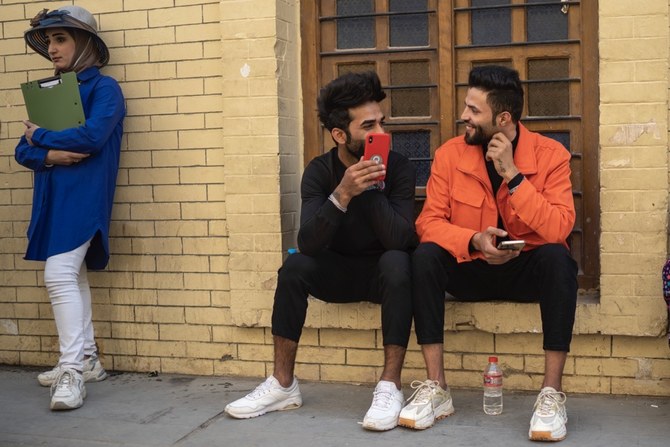
Gazans search for remains after deadly Rafah strike
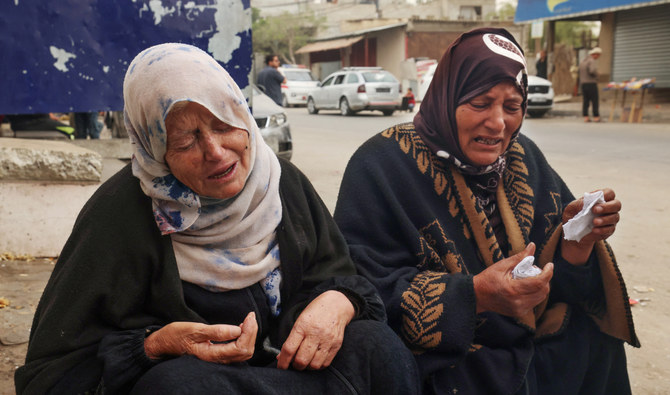
An Israeli strike hit the home where a displaced Palestinian family was sheltering in the southern city of Rafah, relatives and neighbors told AFP as they scraped at the soil with their hands.
Al-Arja said the blast killed at least 10 people.
“We retrieved the remains of children and women, finding arms and feet. They were all torn to pieces.
“This is horrifying. It’s not normal,” he said, hauling concrete and broken olive branches from the wreckage. “The entire world is complicit.”
Soon after the war began on Oct. 7, Israel told Palestinians living in the north of Gaza to move to “safe zones” in the territory’s south, like Rafah.
But Israeli Prime Minister Benjamin Netanyahu has since vowed to invade the city, where around 1.5 million people live in shelters, more than half the territory’s population.
“How is Rafah a safe place?” said Zeyad Ayyad, a relative of the victims. He sighed as he cradled a fragment of the remains.
“I heard the bombing last night and then went back to sleep. I did not think it hit my aunt’s house.”
The search for remains was long and painful. The strike left a huge crater and children picked through the rubble while neighbors removed debris, tarpaulin, a pink top.
“We can see them under the rubble and we’re unable to retrieve them,” Al-Arja said.
“These are people who came from the north because it was said the south is safe.”
“They struck without any warning,” he said.
In a separate strike on the house in Rafah’s Al-Salam neighborhood overnight on Tuesday, rescue crews recovered the corpses of eight family members, including five children and two women, Gaza’s civil defense service said.
“An Israeli rocket hit a house of displaced people,” said resident Sami Nyrab.
“My sister’s son-in-law, her daughter, and her children were having dinner when an Israeli missile demolished their house over their heads.”
Dubai clears up after epic rains swamp glitzy city
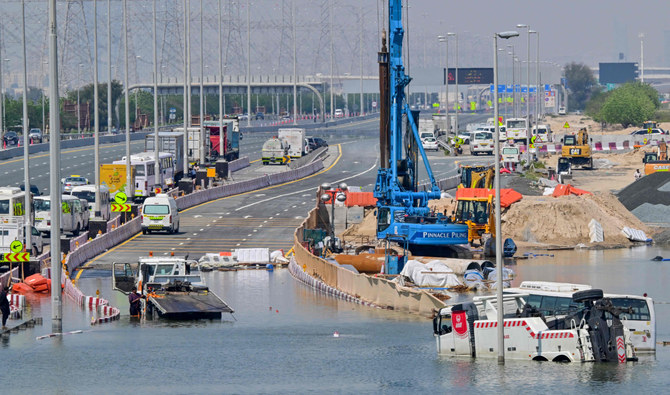
- The rains were the heaviest experienced by the UAE in the 75 years that records have been kept
DUBAI: Dubai was busy on Thursday clearing its waterlogged roads and drying out flooded homes two days after a record storm deposited a year’s worth of rainfall in a day.
Dubai International Airport, a major travel hub, struggled to clear a backlog of flights, and many roads were still flooded in the aftermath of Tuesday’s deluge.
The rains were the heaviest experienced by the UAE in the 75 years that records have been kept.
They brought much of the country to a standstill and caused significant damage.
Flooding trapped residents in traffic, offices, and homes.
Many reported leaks at their homes, while footage circulated on social media showed malls overrun with water pouring from roofs.
Traffic remained heavily disrupted.
A highway through Dubai was reduced to a single lane in one direction, while the main road connecting Dubai with Abu Dhabi was closed in the Abu Dhabi direction.
“This was like nothing else. It was like an alien invasion,” said Jonathan Richards, a Dubai resident from Britain.
“I woke up the other morning to people in kayaks, pet dogs, pet cats, and suitcases outside my house.”
Another resident, Rinku Makhecha, said the rain swamped her newly renovated house, which she moved into two weeks ago.
“My entire living room is just like ... all my furniture is floating right now,” she said.
In Dubai’s streets, some vehicles, including buses, could be seen almost entirely submerged in water.
Long queues formed at petrol stations.
Dubai Airport had not resumed normal operation after the storm flooded taxiways, forcing flight diversions, delays, and cancellations.
Dubai Airport Chief Operating Officer Majed Al Joker told Al Arabiya TV he expected Dubai International Airport to reach 60 to 70 percent capacity by the end of Thursday and full operational capacity within 24 hours.
The airport struggled to get food to stranded passengers, with nearby roads flooded and overcrowding limited access to those who had confirmed bookings.
While some roadways into hard-hit communities remain flooded, delivery services across Dubai, whose residents are used to ordering everything at the click of a mouse, slowly began returning to the streets.
Following Tuesday’s events, questions were raised about whether cloud seeding, a process that the UAE frequently conducts, could have caused the heavy rains.
A UAE government agency overseeing cloud seeding — manipulating clouds to increase rainfall — denied conducting such operations before the storm.
President Sheikh Mohammed bin Zayed Al-Nahyan said in a statement that he had ordered authorities to assess the damage and support families impacted by the storm.
Dubai’s Crown Prince Sheikh Hamdan bin Rashid Al-Maktoum said on X that the safety of citizens, residents, and visitors was the utmost priority.
“At a meeting with government officials in Dubai, we set directives to prepare comprehensive plans in response to natural crises such as the unexpected current weather conditions,” he said.
Hezbollah says 2 fighters killed in Israeli strikes
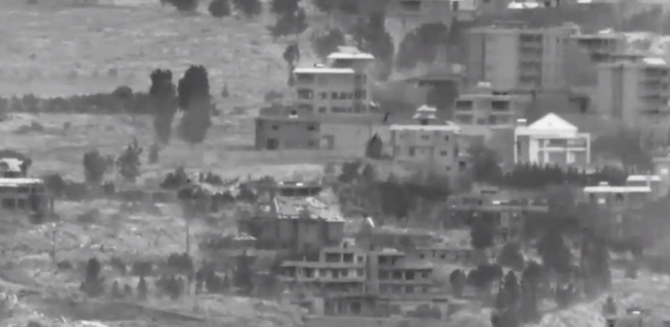
- GPS interference affecting both sides of Lebanese border, source says
BEIRUT: Two Hezbollah fighters were killed on Wednesday as Israel intensified strikes on south Lebanon following an attack by the Iran-backed group that wounded 14 Israeli soldiers.
Israel and Hezbollah have exchanged near-daily cross-border fire since Palestinian militant group Hamas attacked southern Israel on Oct. 7, triggering war in the Gaza Strip.
A security source said: “Hezbollah’s complex attack against the Israeli army in Wadi Al-Aramshe early on Wednesday, which led to the injury of 14 Israeli soldiers, including six with serious injuries, was absorbed by the Israeli side after the painful blow it directed at the party by assassinating three of its field officials.”
The Israeli army responded to the Wadi Al-Aramshe operation on Wednesday night by targeting the town of Iaat in the Bekaa Valley, 5 km from Baalbek. A drone strike hit a warehouse belonging to a member of the Al-Zein family, resulting in light wounds to one civilian.
Israel continues to jam GPS around the Lebanese southern border region, especially during military operations.
A security source said: “This interference negatively affects both the Israeli army and Hezbollah in targeting objectives.”
Hezbollah announced a series of operations since dawn on Thursday, targeting Israeli military sites opposite the Lebanese border.
The group targeted an Israeli force attempting to withdraw a military vehicle that was targeted on Wednesday at Metula, opposite the Lebanese town of Kfarkela.
At dawn, Israeli soldiers in Al-Malikiyah, opposite the Lebanese town of Aitaroun, were targeted by Hezbollah using missiles.
The group also targeted Israeli soldiers in Al-Marj.
“After careful monitoring and anticipation of the enemy’s movement at Al-Marj … they were targeted with missile weapons and suffered a direct hit; some died while others were injured,” the group said in a statement.
Hezbollah attacked Israeli soldiers using missiles in the Hanita forest, opposite the Lebanese town of Alma Al-Shaab.
On Thursday, the party mourned two members killed in Wednesday night’s shelling of Kfarkela. Mohammed Jamil Al-Shami from Kfarkela and Ali Ahmed Hamadeh from Doueir were killed in the Israeli operation.
The Israeli army targeted Lebanese towns with heavy shelling until dawn on Thursday. The town of Khiam was a priority target; correspondents in the area counted seven strikes and 128 artillery and phosphorous shells impacting between 8 p.m. and 4 a.m.
A young man from Habboush, Ahmed Hassan Al-Ahmed, was killed in the shelling and mourned by residents of his town.
Jets struck Hezbollah targets in Khiam, including infrastructure and two military buildings, the Israeli army said.
Israeli drones targeted a house on the outskirts of Markaba and in Blida on Thursday, with casualties reported.
The Israeli army also targeted Kfarkela with two missiles from a drone, and with artillery and phosphorous shells. From Metula opposite the border, Israeli soldiers combed the town with heavy machine guns.
The outskirts of Dhayra, Al-Bustan and Aita Al-Shaab were hit by gunfire from the Israeli position in Birkat Risha and other positions adjacent to the Blue Line.
German airline Lufthansa announced on Thursday it had extended the suspension of flights to Beirut and Tehran until April 30.
The decision was taken on the night of the Iranian attack on Israel last weekend.
UNIFIL spokesman Andrea Tenenti said that the organization’s peacekeepers “remain in their positions and carry out their duties, as well as our civilian staff.”
He added: “The safety and security of UN staff and their families are our priority.”
Dubai clears up after epic rains swamp glitzy desert city
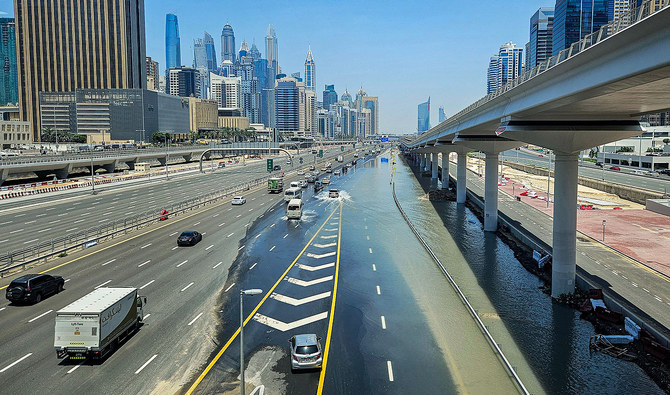
- Rains were the heaviest experienced by the United Arab Emirates in the 75 years that records have been kept
- Flooding trapped residents in traffic, offices and homes, houses’ roofs leaked and malls were overrun with water
DUBAI: Dubai, a city in the desert proud of its futuristic gloss, was on Thursday busy clearing its waterclogged roads and drying out flooded homes two days after a record storm saw a year’s rain fall in a day.
Dubai International Airport, a major travel hub, struggled to clear a backlog of flights and many roads were still flooded in the aftermath of Tuesday’s deluge.
The rains were the heaviest experienced by the United Arab Emirates in the 75 years that records have been kept. They brought much of the country to a standstill and caused significant damage.
Flooding trapped residents in traffic, offices and homes. Many reported leaks at their homes, while footage circulated on social media showed malls overrun with water pouring from roofs.
Traffic remained heavily disrupted. A highway through Dubai was reduced to a single lane in one direction, while the main road that connects Dubai with the capital Abu Dhabi was closed in the Abu Dhabi direction.
“This was like nothing else. It was like an alien invasion,” Jonathan Richards, a Dubai resident from Britain told Reuters.
“I woke up the other morning to people in kayaks with pet dogs, pet cats, suitcases all outside my house.”
Another resident, Rinku Makhecha, said the rain swamped her freshly renovated house she moved into two weeks ago.
“My entire living room is just like ... all my furniture is floating right now,” she said.
In Dubai’s streets, some vehicles, including buses, could be seen almost entirely submerged in water. Long queues formed at petrol stations.
Dubai airport had yet to resume normal operation after the storm flooded taxiways, forcing flight diversions, delays and cancelations.
Dubai Airports Chief Operating Officer Majed Al Joker told Al Arabiya TV he expected Dubai International Airport to reach 60-70 percent capacity by the end of Thursday and full operational capacity within 24 hours.
The airport struggled to get food to stranded passengers with nearby roads flooded and overcrowding limited access to those who had confirmed bookings.
RETURNING SUPPLIES
The storm, which hit neighboring Oman on Sunday, pounded the UAE on Tuesday, with 20 reported dead in Oman and one in the UAE.
While some roadways into hard-hit communities remain flooded, delivery services across Dubai, whose residents are used to ordering everything at the click of a mouse, slowly began returning to the streets.
Rains are rare in the UAE and elsewhere on the Arabian Peninsula, which is typically known for its dry desert climate. Summer air temperatures can soar above 50 degrees Celsius.
Following Tuesday’s events, questions were raised whether cloud seeding, a process that the UAE frequently conducts, could have caused the heavy rains.
But climate experts blame global warming for such extreme weather events.
Researchers anticipate that climate change will lead to heightened temperatures, increased humidity and a greater risk of flooding in parts of the Gulf region. Countries like the UAE where there is a lack of drainage infrastructure to cope with heavy rains can suffer the most.
A UAE government agency that oversees cloud seeding — a process of manipulating clouds to increase rainfall — denied conducting any such operations before the storm.
President Sheikh Mohammed bin Zayed Al Nahyan said in a statement he had ordered authorities to assess the damage and provide support to families impacted by the storm.
Dubai’s Crown Prince Sheikh Hamdan bin Rashid Al Maktoum said on X that the safety of citizens, residents and visitors was the utmost priority.
“At a meeting with government officials in Dubai, we set directives to prepare comprehensive plans in response to natural crises’ such as the unexpected current weather conditions,” he said.
Arab League chief voices Gaza fears in talks with UN official
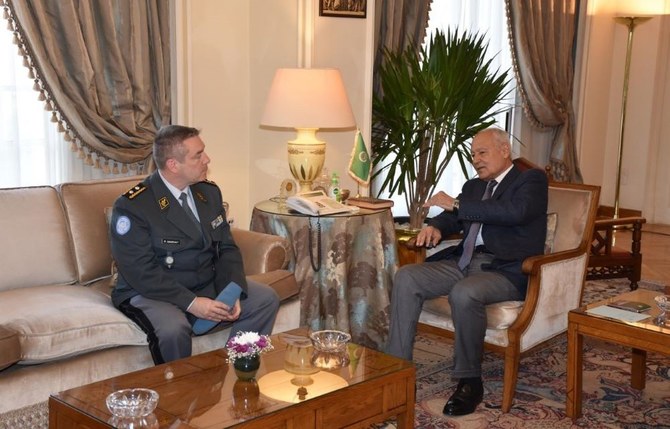
- Secretary-General Ahmed Aboul Gheit met with the UN’s Maj. Gen. Patrick Gauchat
- UNTSO chief briefed the secretary-general on conflicts in several areas monitored by the UN
CAIRO: Arab League Secretary-General Ahmed Aboul Gheit has told a senior UN official that he fears the conflict in Gaza could spiral out control and threaten regional security.
In a meeting in Cairo with Maj. Gen. Patrick Gauchat, head of mission and chief of staff of the UN Truce Supervision Organization, Aboul Gheit highlighted the need to implement the UN Security Council’s ceasefire resolution, and provide urgent humanitarian aid to the famine-stricken population in Gaza.
Gamal Roshdy, a spokesperson for the Arab League chief, said that the meeting discussed the regional situation, with Aboul Gheit saying that Israel’s war on Gaza violated international law and humanitarian principles.
The UNTSO chief briefed the secretary-general on conflicts in several areas monitored by the UN, including the Blue Line, which delineates the truce between Lebanon and Israel.
Aboul Gheit said that political resolutions remain the most effective means to ensure security for all parties.
However, achieving such resolutions remains challenging while Israel pursue its objectives through military force and by targeting civilians, he said.
According to the UNTSO website, the Security Council, in Resolution 50 (1948), called for a cessation of hostilities in Palestine on May 29, 1948, and decided that the UN Mediator should supervise the truce with the assistance of a group of military observers.
The first group of military observers, established in 1949 to supervise the implementation of the Israel-Arab Armistice Agreements, became known as the UN Truce Supervision Organization.
UNTSO observers in the Middle East to monitor ceasefires, supervise armistice agreements, prevent isolated incidents from escalating, and assist other UN peacekeeping operations in the region.







